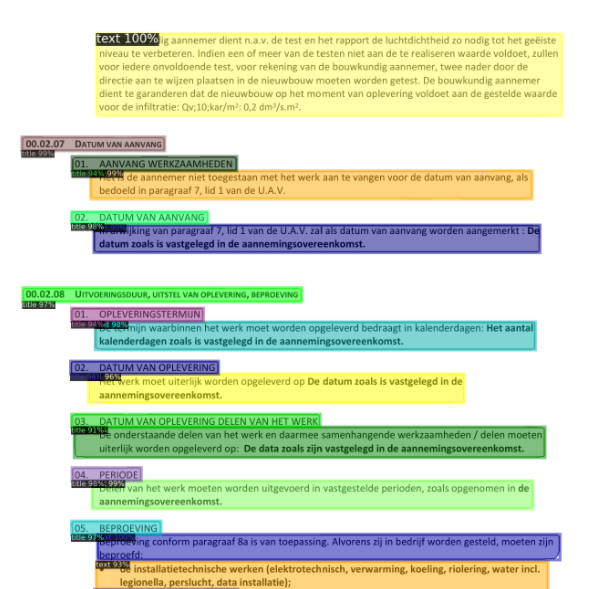The merging of humans and machines is happening now - 3 AI techniques used in tendering

Artificial intelligence (AI) refers to the ability of machines to exhibit intelligent behaviour. AI will change the way we live, work and travel. It will also impact the way we answer tenders. Currently, many bid and tender managers still walk out with folders full of printed tender documents with sticky notes and highlighted texts. This is about to change. Humans and machines are going to work together more and more and there will be a ‘digitisation revolution’ in the coming years.
Below, we explain how various fields of AI can be brought together to ensure a strong combination of human and machine. We will discuss the application of the AI disciplines of computer vision, natural language processing and machine learning when responding to tenders.
Computer Vision
Computer Vision developers aim to give computers the ability to process images in much the same way as humans do. Computer Vision is based on deep learning. This is a form of machine learning that uses the architecture of the human brain. Computer Vision aims to allow a system to make its own predictions and decisions based on context. Just like our brain. This means that the computer is able to identify objects and make appropriate decisions based on what it “sees”.
Images are examples of unstructured data, they consist of endless pixels. Not only the human brain, but also artificial systems will soon be able to turn this jumble of pixels into a structured data set. The human brain does this automatically, while the system has a technical step-by-step plan in which models must be trained. In the case of Brainial, we transform all tender documents into an image. Our computer vision models are specifically trained on documents and document layouts, including all their characteristics. For example, one computer vision model has learned the characteristics of objects such as paragraphs, bullet point text, images and tables. Another computer vision model detects the metadata from drawings. The texts are extracted from the objects using OCR technology and are then converted to structured data format and processed using Natural Language Processing. A structured data format is a way of representing data that is easy for a computer to understand and consistent. Instead of large chunks of text, it is divided up and classified, a bit like a human using a marker to highlight a document.

Natural Language Processing
Natural Language Processing (NLP) is the technology used to help computers understand the natural language of humans. With NLP we create a bridge between the human way of communicating and the computer way of communicating. An NLP system consists of a pipeline with a number of components that take care of the processing of the text. Each component provides structure to the text so that further processing becomes easier, such as removing stop words or replacing all language-specific letters with normal ones (e.g. from é to e). The first components differ in task from the later components, which are more focused on analysing concepts and relationships. An example of this is text categorisation, which divides pieces of text into categories such as legal, procedural, technical, financial, etc. Methods used range from rule-based methods including regular expressions to statistical and machine learning models. At Brainial, we use a combination of rule-based methods and machine learning models.
Brainial has developed its own models which use Natural Language Processing to interpret and classify the formatted text. We also use it to extract specific elements, such as exclusion grounds, award criteria and planning, and organisation-specific issues from tender documents. In addition, metadata can be detected and extracted from the tender documents. All this ensures that, within minutes, a complete tender is fully analysed, classified and can be presented in a user-friendly manner. On the basis of this first systems analysis, an initial bid / no bid consideration can be made and immediate insight provided into the critical elements contained in the tender without a human having read even one word of the tender.
An additional advantage of human-machine cooperation is that fewer elements are overlooked. Almost every bid and tender manager admits that he or she has overlooked information on occasion. This chance is significantly reduced when a machine reads along with you. This leads to better proposals and a reduction of failure costs attributable to the tender phase.
Machine Learning
Machine learning is a broad field of AI that deals with the development of algorithms and techniques that enable computers to learn. Machine learning is a very diverse technique that uses different software, algorithms and techniques to build specific models that best fit the situation. Machine learning does not consist of a concrete set of algorithms that can be used in a standardised way.
After tender documents are analysed by the Brainial system, people start working with them. They determine that certain results are more important than others and assign actions or other labels. An example is that the piece of text “…. 90-day payment term…” is assigned the action “management approval” and the label “high risk”. The next time the machine finds a similar piece of text containing the example of a 90-day payment term, it will automatically assign the action “management approval” and the label “high risk”. Brainial applies special machine learning techniques that can make accurate predictions based on relatively few examples.

Conclusion
Humans and machines will increasingly work together. This will result in a lot of manual work no longer needing to be done, information can be extracted, analysed and presented in a user-friendly way at lightning speed. It will ensure that, as a human being, you can use all your experience and knowledge during creative processes, value-adding activities and when determining a winning strategy. Whereas a machine can process a lot of data at a rapid pace, a human can read between the lines and understand the client’s situation. All we can say is, embrace the new developments, use them to your advantage and they will help you to work more efficiently and effectively, allowing you to spend more time on the fun stuff and on the things you can really do to make a difference.

.jpg)


